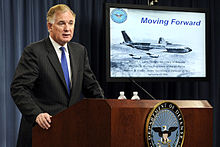
The Boeing 767 is an American wide-body aircraft developed and manufactured by Boeing Commercial Airplanes. The aircraft was launched as the 7X7 program on July 14, 1978, the prototype first flew on September 26, 1981, and it was certified on July 30, 1982. The initial 767-200 variant entered service on September 8, 1982, with United Airlines, and the extended-range 767-200ER in 1984. It was stretched into the 767-300 in October 1986, followed by the 767-300ER in 1988, the most popular variant. The 767-300F, a production freighter version, debuted in October 1995. It was stretched again into the 767-400ER from September 2000.

The Northrop Grumman E-8 Joint Surveillance Target Attack Radar System is a retired United States Air Force (USAF) airborne ground surveillance, battle management and command and control aircraft. It tracks ground vehicles and some aircraft, collects imagery, and relays tactical pictures to ground and air theater commanders. The aircraft was operated by both active duty USAF and Air National Guard units and also carried specially trained U.S. Army personnel as additional flight crew.
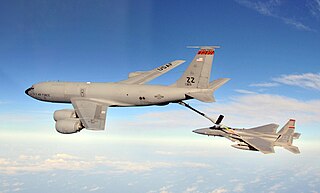
The Boeing KC-135 Stratotanker is an American military aerial refueling tanker aircraft that was developed from the Boeing 367-80 prototype, alongside the Boeing 707 airliner. It has a narrower fuselage and is shorter than the 707. Boeing gave the aircraft the internal designation of Model 717. The KC-135 was the United States Air Force (USAF)'s first jet-powered refueling tanker and replaced the KC-97 Stratofreighter. The KC-135 was initially tasked with refueling strategic bombers, but it was used extensively in the Vietnam War and later conflicts such as Operation Desert Storm to extend the range and endurance of US tactical fighters and bombers.

The Airbus A330 is a wide-body aircraft developed and produced by Airbus. Airbus conceived several derivatives of the A300, its first airliner from the mid-1970s. Then the company began development on the A330 twinjet in parallel with the A340 quadjet and launched both designs with their first orders in June 1987. The A330-300, the first variant, took its maiden flight in November 1992 and entered service with Air Inter in January 1994. The slightly shorter A330-200 variant followed in 1998.
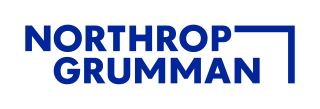
Northrop Grumman Corporation is an American multinational aerospace and defense technology company. With 95,000 employees and an annual revenue in excess of $30 billion, it is one of the world's largest weapons manufacturers and military technology providers. The firm ranked No. 101 on the 2022 Fortune 500 list of America's largest corporations.

Future Strategic Tanker Aircraft (FSTA) was a British project to procure Airbus A330 Multi Role Tanker Transport aerial refuelling (AR) and air transport (AT) aircraft for the Royal Air Force, to replace older models such as the VC10s and TriStars.

The Airbus A330 Multi Role Tanker Transport (MRTT) is a European aerial refuelling and military transport aircraft based on the civilian Airbus A330. A total of 16 countries have placed firm orders for approximately 68 aircraft, of which 51 had been delivered by 30 November 2020. A version of the A330 MRTT, the EADS/Northrop Grumman KC-45, was selected by the United States Air Force for its aerial tanker replacement programme, but the programme was cancelled.
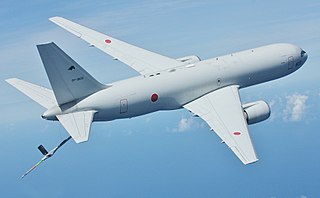
The Boeing KC-767 is a military aerial refueling tanker and transport aircraft developed from the Boeing 767-200ER. The tanker received the designation KC-767A, after being selected by the U.S. Air Force (USAF) initially to replace older KC-135Es. In December 2003, the contract was frozen and later canceled due to corruption allegations.
The Northrop Grumman E-10 MC2A was planned as a multi-role military aircraft to replace the Boeing 707-based E-3 Sentry and E-8 Joint STARS, the Boeing 747-based E-4B, and the RC-135 Rivet Joint aircraft in US military service. The E-10 was based on the Boeing 767-400ER commercial airplane.

The EADS/Northrop Grumman KC-45 was a proposed aerial refueling tanker aircraft based on the Airbus A330 MRTT. The United States Air Force (USAF) had ordered 179 KC-45As in the first stage of replacing the aging Boeing KC-135 Stratotanker tankers currently in service. However, the contest was reopened in July 2008, after Boeing's protest of the award was upheld. In response to the new contest, on 8 March 2010, Northrop Grumman announced it was abandoning its bid for the new contract, with its CEO stating that the revised bid requirement favoured Boeing. On 20 April 2010, EADS announced it was re-entering the competition and entered a bid with the KC-45. Eventually, the USAF selected the Boeing KC-46 Pegasus.
Foosackly's is an American chain of chicken restaurants in coastal Alabama and Northwest Florida.
Airbus Group, Inc. represents the North American activities of European multinational aerospace company Airbus. Headquartered in Herndon, Virginia, this American arm of the company participates in U.S. Department of Defense programs, in some cases as a prime contractor. The American unit operates under a Special Security Arrangement which allows it to work independently on some of the most sensitive United States defense programs despite its foreign ownership. It employs approximately 3,200 people and had 2011 revenues of $1.3 billion.

The T-X program is a United States Air Force development and acquisition program for a new two-seat jet trainer to replace the Northrop T-38 Talon. On 27 September 2018, the US Air Force selected the Boeing/Saab T-X entry to become its trainer aircraft. The new aircraft was given the designation and name "T-7 Red Hawk" in September 2019. The Air Force's initial plan is to purchase 351 T-7s, and has an option to purchase up to 475.
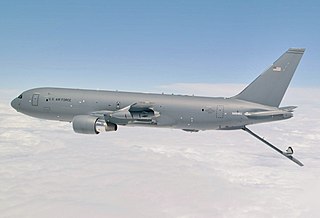
The Boeing KC-46 Pegasus is an American military aerial refueling and strategic military transport aircraft developed by Boeing from its 767 jet airliner. In February 2011, the tanker was selected by the United States Air Force (USAF) as the winner in the KC-X tanker competition to replace older Boeing KC-135 Stratotankers. The first aircraft was delivered to the Air Force in January 2019. The Air Force intends to procure 179 Pegasus aircraft by 2027.

The Long Range Strike Bomber (LRS-B) is a development and acquisition program to develop a long-range strategic bomber for the United States Air Force, intended to be a heavy-payload stealth aircraft capable of delivering thermonuclear weapons. Initial capability is planned for the mid-2020s. A request for proposal to develop the aircraft was issued in July 2014. The Air Force plans to procure at least 100 of the LRS-B aircraft at a cost of an estimated $550 million each, with potentially as many as 200 units being considered to enter service eventually. A development contract was awarded to Northrop Grumman for its B-21 Raider in October 2015. Due to the sensitive nature much about the project is highly classified and little information is available to the public. As of late 2019, it was known that construction of the aircraft had commenced, and on December 2, 2022, it was unveiled to the public.
The Mobile Aeroplex at Brookley is an industrial complex and airport in Mobile, Alabama, United States, which lies adjacent to the western shore of Mobile Bay. It is owned and operated by the Mobile Airport Authority. It was known by a variety of names until being renamed in 2010 as the Brookley Aeroplex. In the fall of 2013, the Brookley Aeroplex was rebranded as the Mobile Aeroplex at Brookley.
The Lockheed Martin Sea Ghost was a proposal to fulfill the United States Navy's requirement for an Unmanned Carrier-Launched Airborne Surveillance and Strike aircraft.

The Airbus U.S. Manufacturing Facility is an assembly site for Airbus's Commercial Airplanes division, located at the Mobile Aeroplex at Brookley in Mobile, Alabama, United States. The plant is an assembly and delivery site for Airbus commercial aircraft in the United States and one of the largest employment centers in the state. The site is one of four final assembly and delivery points for the Airbus A320neo family and one of two final assembly and delivery points for the Airbus A220.

